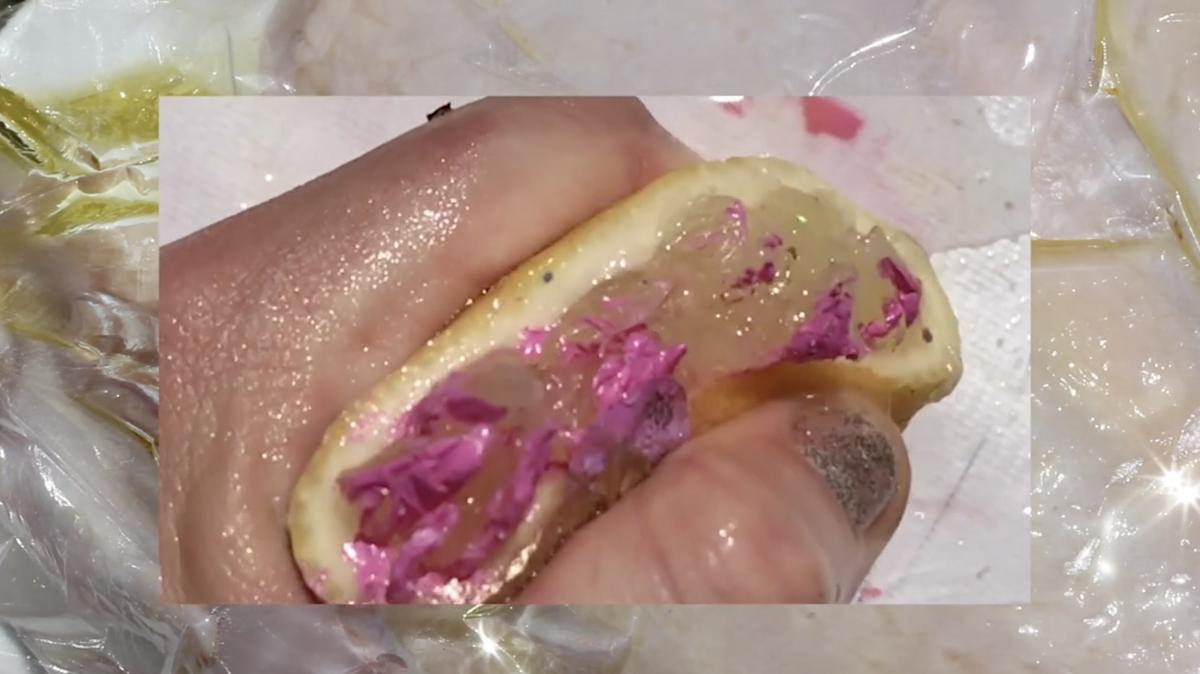Laura Duffy is a Wellington based artist whose work explores the intersections of religion, abjection and technology. In recent works such as Fruit Flesh Bless (2016) and Click Analyze to begin (2017), Duffy highlights and challenges dominant social, political and cultural ideologies whilst also critiquing the screen and it’s relationship femme bodies.
In western culture, religion dictates our legal system, shapes our ideologies and ideas around politics, sexuality and gender. It is a system that places prominence on structure, reason and meaning. We fall into it because it feels safe. There is nothing to fear, only black and white, right and wrong, no in-between.
Whilst heavily critiquing and challenging the influence of religion, in particular Catholicism, Duffy’s work also celebrates its’ inherent theatricality and ritual. In Oh My Lord (2016), Duffy feeds the Lord’s Prayer through Google translate, converting it to multiple different languages then back to English again. Through this performance the prayer becomes familiar yet unfamiliar. The sentences are strung together in a strange manner, and the cold, sterile robotic voice speaks the verse back to the viewer without any hint of personality and human-ness. To present the abject alongside the Lord’s Prayer is to politically critique the relationship that the human has to religion and to actively dismantle it. Something that puts a high prominence on reason is placed alongside something that has no reason at all. Duffy’s work is a disturbing reminder that the world is a lot more fluid and complex than simply black and white, right and wrong. Underneath religion and the structures that we integrate into our lives, abjection looms.
In her 1982 essay Approaching Abjection Julia Kristeva describes the abject as that which “disturbs identity, system, order. What does not respect borders, positions, rules”. For Duffy, use of this aesthetic signals a challenge to religion’s binaries, logic and reason. When we secrete fluids, when our skin is broken, when we have an internal stomach reaction, I am reminded of the fact that I am a sack of meat that will eventually die. Such abjection reminds the human that we are not immanent.
Duffy’s work reveals a fascination with the concept of ingesting. In Click Analyze to begin (2017) Duffy presents a sickly sweet colour palette of dripping, oozing materials shot at high resolution. Rotting food and bodily matter become a medium. Visually compelling and grotesque, it is repulsive yet attractive contrast of beauty and horror. Just as we enjoy horror movies and stop to stare at car crashes, we are disgusted but fascinated.
In 2018 everyone owns a smartphone, has various different social media platforms, and is aware the Kardashians and American political dramas. Digital connectivity is an operational force, both invasive yet intimate and increasingly more difficult to avoid. We can thank the Internet for helping New Zealand to become more in tune with global issues and ideas, yet such technological advancements also bombard us with commercials and various corporate agendas.
Fruit Flesh Bless (2016) is an installation work Duffy created for the group exhibition Angelwave at Play_Station gallery. Fruit Flesh Bless was displayed on three iphones and an imac. While there is a sense of freedom in that the viewer can interpret the work however they want, the installation also conveyed a strong sense of claustrophobia and stress, with multiple things happening at once on various devices. What does it mean for Duffy to place The Lords Prayer, Abject Imagery and iphone screens in the same place?. What is the relationship between our abject bodies, religion and technology? How do they negotiate and interact with each other? The result is ultimately up to the viewer to decide, but for Duffy, to expose binaries is to simultaneously dismantle them. She presents them to us but also asks us to challenge them.
Most of us are familiar with Burger King commercials; the theatricality of the bun bouncing, the cheese oozing and the water droplets glistening on the sliced tomatoes. We are also familiar with the famous hair swoosh in Pantene commercials. The screen is a powerful tool that is often used as a medium to present and reinforce ideas. It is also a platform to push corporate agenda and capitalist ideals onto a wider audience. Women are heavily catered to the Patriarchal gaze, treated as sex objects to be consumed. Men want them and women want to be them. The screen captivates us. It presents a fantasy alternate world, and we buy into it willingly.
Born into an era of media saturation, Duffy’s works function as an alternate version of these commercials. Instead of the usual flowing silky hair, perfect flawless skin and “desirable beauty”, Laura presents fleshy materials, sticky sweet colours, oozing bodily matter and rotting food. She exposes and critiques the objectification of the female form and the role that the screen plays in such representation.
Religion values structure, Abjection threatens it, technology is invasive and intimate and the screen is a platform to present and reinforce ideas. We ingest these ideas, ideas around sexuality, food, and gender among many other things. Laura Duffy successfully and seamlessly explores these ideas and serves them up to us on a sickly sweet platter. It is beautiful and grotesque. I don’t want to look and yet I can’t look away.
